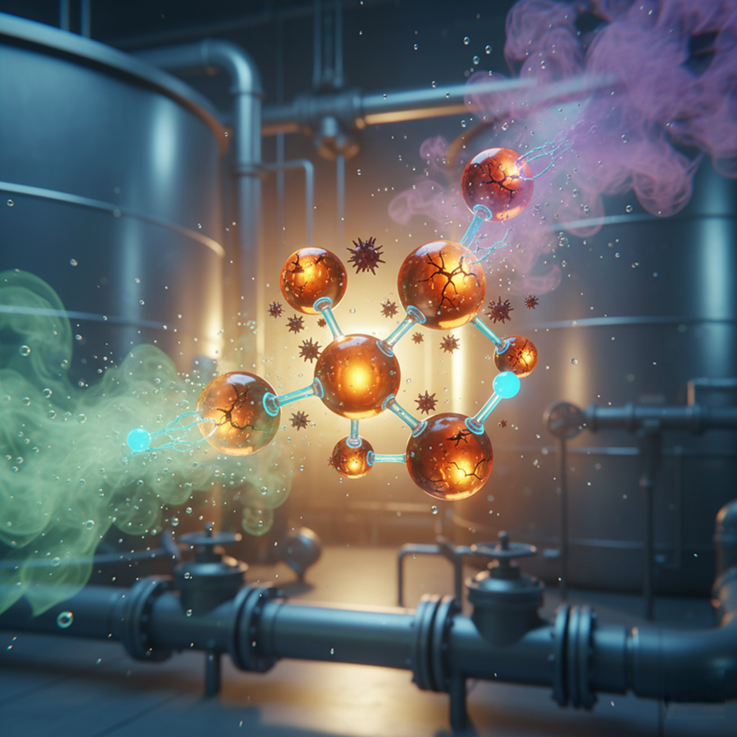
Maximizing Return on Investment (ROI): Managing Resin Efficiency to Reduce Operating Costs
The resin used in water softeners is not just a consumable; it is a strategic asset that represents a significant portion of the plant’s investment. In an environment where pressures to reduce operating costs and ensure continuity of service are increasing. Understanding how resin deteriorates and how to extend its lifespan becomes critical. This article outlines the engineering and financial guidance for plant operators to ensure they are not forced to replace this asset prematurely.
Failure here is not just about replacing a consumable; it is about the collapse of a financial plan. Each service cycle during which the resin loses some of its effectiveness represents an accumulated waste of chemicals and energy, and an advance payment for a replacement that has yet to arrive. Therefore, shifting from a culture of reactive failure to a culture of proactive management and maintenance is not a luxury; it is the cornerstone of maximizing the return on investment from this hidden asset.
Learn more about the role of water softener resin in water treatment plants
Part One: Silent Deterioration: How External Factors Steal Resin’s Lifespan
There are three main factors that attack the resin structure, each causing irreparable financial and operational losses:
Oxidative Corrosion (Chlorine and Disinfectants)
Free chlorine and other disinfectants are the most formidable enemies of ion exchange resins. These substances attack the cross-linking polymer structure of the beads.
- Problem: When the polymer bonds break, the resin bead becomes brittle, softer, and swells abnormally. This makes it susceptible to mechanical fracture, leading to attrition during backwashing.
- Financial Impact: Premature resin breakdown and actual loss of working material, which reduces the total working volume and thus reduces overall productivity.
- Operational Solution: Strict pretreatment control. Chlorine must be completely removed or neutralized (often using activated carbon filters or bisulfite injection) before it comes into contact with the resin. The disinfectant injection point must be carefully calibrated to ensure that the resin is not exposed to residual doses exceeding 0.1 ppm. It is the safe limit for most robust resins.
Organic and Mineral Fouling
Fouling occurs when unwanted compounds accumulate on the active sites of the resin or within its pores:
- Problem: Iron, manganese, and organic matter (such as tannins) are the most common. This fouling does not necessarily destroy the resin, but rather hampers its efficiency by blocking the ion exchange sites.
- Financial Impact: Dramatically increased chemical costs. A contaminated resin requires significantly larger quantities of salt or regenerating chemicals to achieve the same degree of regeneration, meaning a higher cost per cubic meter of water production. For example, iron fouling can double the required salt dose, which is the essence of operational waste.
- Operational Solution: Implement periodic chemical cleaning programs using specialized solutions (such as acids or mild oxidants) to remove stubborn fouling, rather than relying solely on a salt regeneration cycle. Dealing with organic contamination may require the use of a special resin to absorb the organics prior to the water softening stage.
Mechanical Stress (Physical Breakage)
- Problem: Resulting from excessively high flow rates during the service or backwash cycle, and rapid rises and falls in temperature and pressure.
- Financial Impact: Actual physical loss of resin. Broken beads can clog internal strainers, leading to costly and unscheduled downtime for maintenance. Physical loss also requires periodic refilling, which increases routine maintenance costs.
- Operational Solution: Carefully calibrate the backwash speed to ensure that the resin bed expansion process is within the recommended range (typically 50-75%) to prevent excessive stress on the beads.
Read more about why resin is important in water treatment.
Section Two: Operational Tactics to Maximize Regeneration Efficiency
The regeneration process is where the most money is spent on consumable chemicals (salt). Improving this process means direct savings. It is measured by the cost of salt per cubic meter of water produced.
- Efficiency versus quality: The plant operator must understand that there is an economic balance between the quality of the produced water and the amount of salt used. Increasing the salt dosage above a certain level adds only a small amount of capacity, but it significantly increases the cost. Optimizing regeneration depends on minimizing “overdosing.” The closer the dosage is to the minimum that ensures the desired water quality, the more financially efficient the system will be.
- Analysis: Conduct periodic tests to establish a curve showing the relationship between salt dosage and ion capacity efficiency to determine the optimal dosage. That achieves the highest exchange capacity at the lowest salt cost.
- Contact time control: Simply pumping salt is not enough; it is important to ensure that the brine solution is in contact with the resin for the recommended period of time (usually between 30 and 60 minutes). Poor contact time reduces the ion exchange reaction, leading to incomplete regeneration and reduced operating capacity in the next cycle. In other words, you are “wasting” the pumped salt without obtaining its full value. This leads to salt waste and an incomplete regeneration process, which reduces the duration of the next cycle.
Section Three: Laboratory Monitoring: Moving from Guessing to Certainty
To ensure the longevity of an investment asset with the value of resin, a routine laboratory monitoring approach must be adopted, rather than waiting for signs of failure to appear.
- Importance of Exchange Capacity Analysis: Resin samples must be taken and analyzed in the laboratory to determine the remaining operating capacity. This provides the operator with an accurate schedule for when the resin will need to be replaced. Enabling financial planning and avoiding last-minute purchases.
- Contamination Analysis: Laboratory chemical tests reveal the amounts of iron, copper, calcium, and silica accumulated on the resin beads. This analysis allows the plant to determine the type of chemical cleaning program required (do we need mineral or organic removal?) instead of applying ineffective and costly general treatments.
Section Four: Key Performance Indicators (KPIs) for Resin Replacement
Rather than waiting for catastrophic failure to occur, plant operators should monitor the following indicators:
- Increasing salt consumption per cubic meter: This is the most significant financial indicator. If the amount of salt required to produce the same volume of treated water continues to increase, this indicates that the resin’s efficiency has deteriorated. It’s time to plan for replacement.
- Reduced service life: The system must be regenerated more frequently to produce the same volume of water. This increases pumping and valve cycles, leading to increased energy consumption and water loss during washing.
- Hardness Leakage: If calcium or magnesium levels begin to gradually rise in service water outside the permissible limits immediately after regeneration. This indicates that the resin has lost the ion exchange capacity necessary to effectively retain ions.
Conclusion
Investing in proactive resin monitoring and maintenance programs (periodic testing, chemical cleaning, and regeneration process optimization) is not an additional cost. Rather, it is direct insurance against major unplanned replacement costs and ensures continued operation at peak operational efficiency. Extending the life of the resin by an additional two years can save the plant a significant amount of money, enhancing the overall return on investment.

























